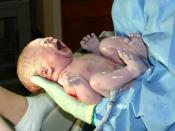Critical Observation Paper
Subject A being the parent was observing subject B being the infant. Subject A observes that subject B cries for various reasons. When an infant expresses a need to cry it is the parents responsibility to find out why they are crying. A primary trait of infants is to cry when they want to communicate their needs and discomforts that require some attention. The parent primarily needs to make sure the infant is not in any pain or discomfort that requires any medical attention. Once that is accomplished its all about trial and error.
Infants who cry excessively may have gastrointestinal problems which, is a form of abdominal pain (Illingworth 1954). This form of abdominal pain is called "colic" which is a crying behavior in infants (Illingworth 1954). During these crying episodes parents need to be more attentive and loving to the infant. Calmly acknowledging and accepting their feelings may be what the infant needs.
When infants cry it may be difficult to know why they are crying. There are many ways to find out why the infant is indeed crying. For example, subject B is crying and subject A feeds the infant. The infant is not crying anymore. Now subject A realizes the reason the infants was crying was because it was hungry. Some methods to try when an infant is crying is to rock or simply try to distract the infant with singing or talking etc.
Method
Naturalistic Observation is the best method used in this situation since the subject is an infant. This observation method operates well when using it on infants because it prevents any abuse or forcing them to cry for an observation. Using this method for the reason that researchers can observe how infants react in the natural setting. For instance,



Cry
This is a great experiment to tell why an infant cries.
1 out of 2 people found this comment useful.